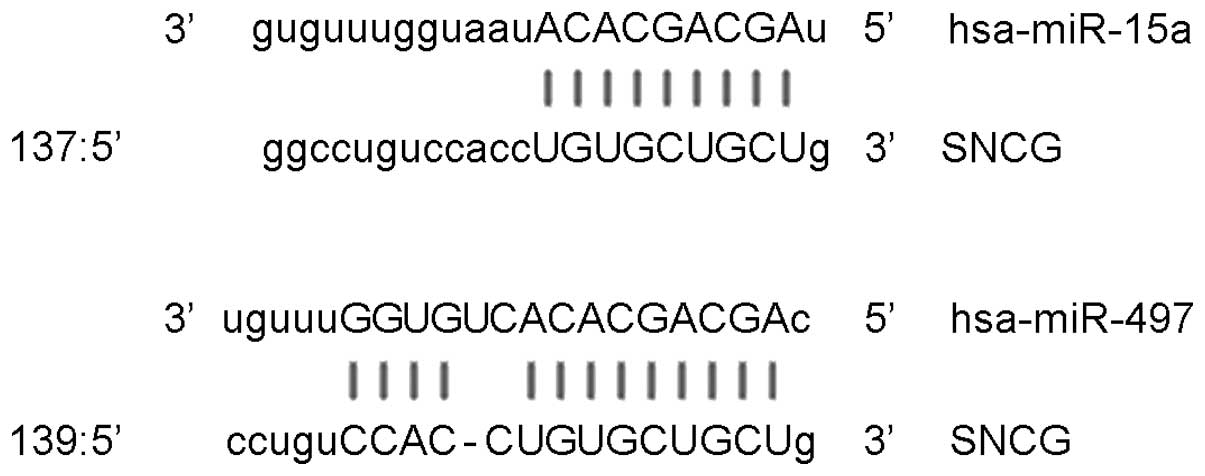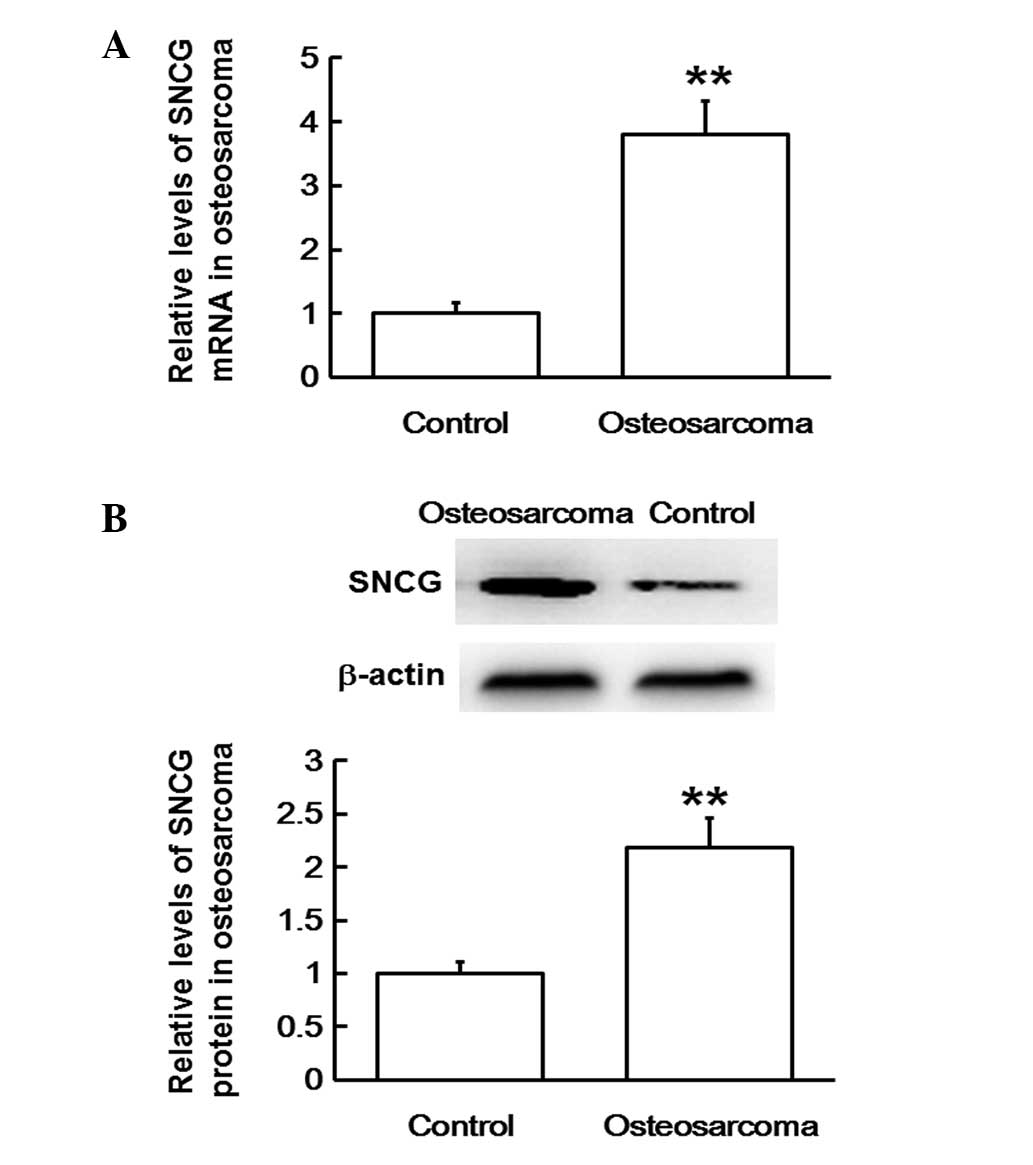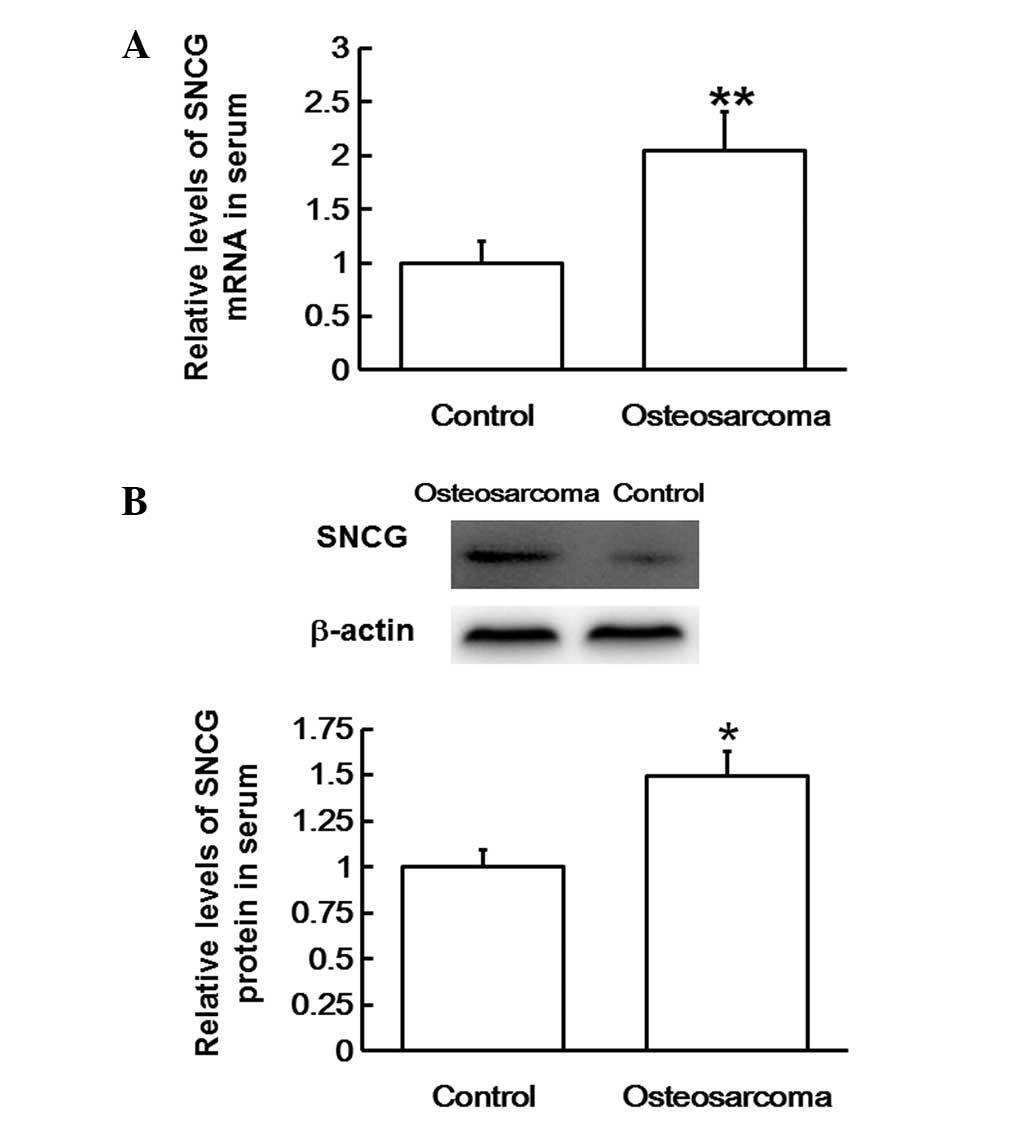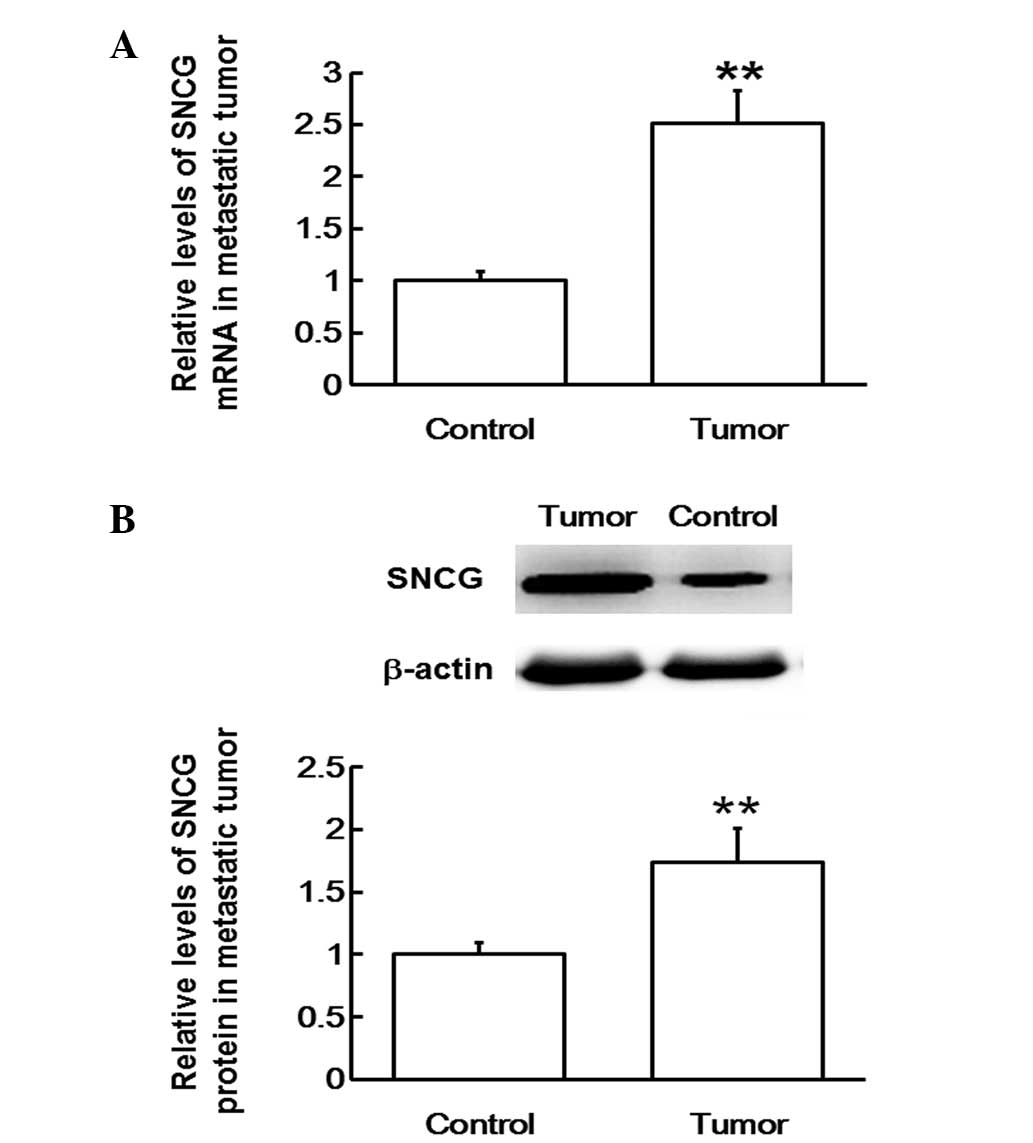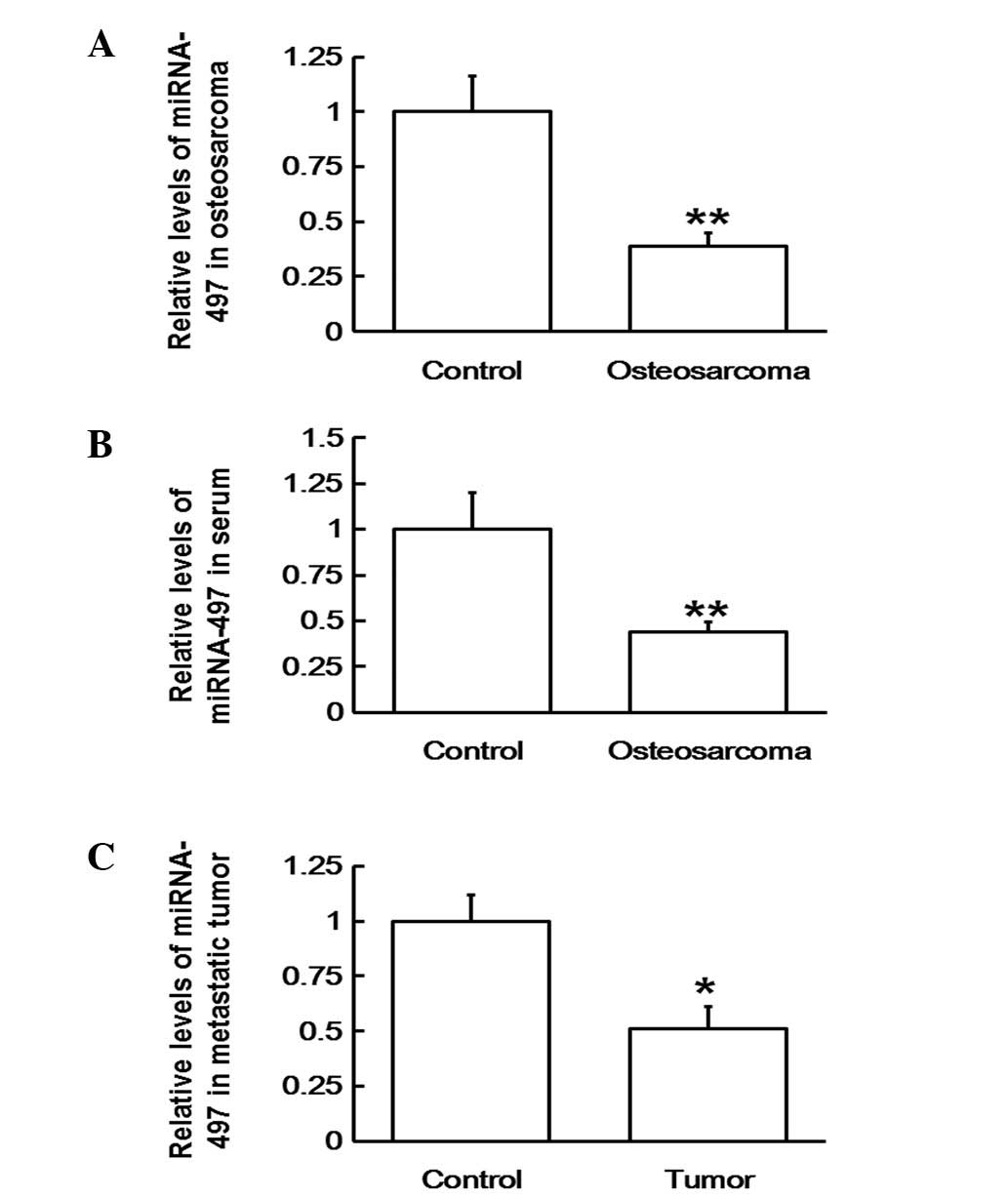Downregulation of microRNA‑497 is associated with upregulation of synuclein γ in patients with osteosarcoma
- Authors:
- Published online on: October 26, 2016 https://doi.org/10.3892/etm.2016.3838
- Pages: 3761-3766
Abstract
Introduction
Osteosarcoma is a highly malignant primary tumor of the bone. Often occurring in the bones and skeleton or their auxiliary tissues, osteosarcoma displays characteristics of osteoid tissues directly formed by tumor cells (1). The majority of patients with osteosarcoma undergo amputation to remove the affected bone; however, post-amputation five-year survival rates remain low at 5%-20% (2). Therefore, patients are administered high-dose chemotherapy, including cisplatin, adriamycin and methotrexate, prior to the operation (3), and radical surgery remains the first-line therapeutic strategy for the treatment of osteosarcoma. With the promotion of radical surgery and high-dose chemotherapy, the five-year survival rates for patients with osteosarcoma have increased to ~70% (4). The majority of patients with late osteosarcoma present with tumor metastasis, in particular lung metastasis, in addition to multiple organ failure. However, the exact mechanism of osteosarcoma has yet to be elucidated, despite the continual efforts made by researchers (5). The occurrence and development of osteosarcoma is regulated by multiple interconnected pathways involving several types of mRNA and microRNA (miRNA/miR). One study reported that miR-195 was able to inhibit the invasion and migration of osteosarcoma by regulating fatty acid synthase factor (6).
Synuclein γ (SNCG), also known as breast cancer specific gene 1, belongs to the synuclein gene family, which is highly conserved in mammals (7). SNCG was initially isolated from breast cancer (8). Subsequently, a study revealed that SNCG is involved in the occurrence and development of breast cancer (7). In recent years, it has been identified that SNCG is also important in other types of tumors, including breast, gallbladder, pancreatic and uterine cancer (9–13). However, whether SNCG has regulatory effects on the proliferation and migration of osteosarcoma cells has yet to be determined. In the present study, the effects of SNCG on the proliferation and invasion of osteosarcoma, in addition to the regulatory mechanism of miR-497 on SNCG, were investigated.
Materials and methods
Patients
Between December 2010 and August 2013, a total of 36 patients were diagnosed with osteosarcoma at The Second Hospital of Shandong University (Jinan, China), according to the 2002 World Health Organization (WHO) classification standards (14). During this time period at the same hospital, 26 healthy subjects were enrolled as the control group to provide control blood samples. The staging of the disease was determined according to the Enneking staging standard, as follows: Stage I (low-grade malignancy), stage II (high-grade malignancy) and stage III (metastasis) (15). Patients with stage III osteosarcoma (lung metastasis; n=15) were selected to undergo tissue resection. Only patients with lung metastases at stage III were included in the present study. Patients received resection of osteosarcoma and lung metastases at our hospital, and received no hormones, Chinese traditional drugs, or radiochemotherapy prior to surgery. Additional inclusion and exclusion criteria were set according to the standards outlined by the WHO (14). All procedures were approved by the Ethics Committee of Shandong University (Jinan, China). Written informed consent was obtained from all patients or their families.
Samples
Fasting peripheral blood was collected from all 36 patients in the morning. Serum was separated by density gradient centrifugation of 10–15 ml peripheral blood at 400 × g for 10 min, and was subsequently stored in liquid nitrogen. Stage III patients with osteosarcoma (n=15) underwent surgery for osteosarcoma (amputation or limb salvage surgery) and lung metastasis tissue resection, with negative adjacent tissues (>5 cm away from tumor foci) used as controls. Tissue samples were stored in liquid nitrogen.
Bioinformatics
Bioinformatics is the predominant method used for the functional analysis of miRNA. A previous study revealed evidence of the regulation of SNCG by one of its upstream mRNAs, miR-15a (16). Using miRanda (www.microrna.org/microrna/getExprForm.do; version 2010), TargetScan (www.targetscan.org/vert_61; version 6.2), PieTar (www.pictar.mdc-berlin.de; version 2007) and BibiServ (www.bibiserv.techfak.uni-bielefield.be/bibi/Tools.html; version 2013) databases, the miR-15 family genes were screened (miR-15a, miR-15b, miR-16, miR-195, miR-424 and miR-497), and miR-497 was selected for evaluation in the present study, due to it having similar SNCG-binding sites to miR-15a (Fig. 1).
Reverse transcription-quantitative polymerase chain reaction (RT-qPCR)
Total RNA was extracted using TRIzol reagent (cat no. 10606ES60; Yeasen, Shanghai, China) and purified using a miRNeasy Serum/Plasma kit (Guangzhou Jianlun Biological Technology Co., Ltd., Guangzhou, China), according to the manufacturer's protocol. The purity of RNA was determined by the absorbance ratio at 260/280 nm using ultraviolet spectrophotometry (NanoDrop ND-1000; Thermo Fisher Scientific, Waltham, MA, USA). Next, cDNA was obtained by reverse transcription (TIANScript RT kit; Tiangen Biotech Co., Ltd., Beijing, China) of 1 µg RNA and stored at −20°C. RT-PCR was performed using a SuperReal PreMix kit (FP204; Tiangen Biotech Co., Ltd.). The primers for SNCG were as follows: Upstream, 5′-ACACCCACCATGGATGTCTT-3′ and downstream, 5′-ACAGTGTTGACGCTGCTCAC-3′. The primers for β-actin were as follows: Upstream, 5′-TGTTTGAGACCTTCAACACCC-3′ and downstream, 5′-AGCACTGTGTGTTGGCGTACAG-3′. PCR amplification was performed on an iQ5 Real-Time PCR Detection System (Bio-Rad Laboratories, Inc. Hercules, CA, USA), as follows: Initial denaturation at 95°C for 60 sec; 45 cycles of denaturation at 95°C for 5 sec, annealing at 60°C for 15 sec and elongation at 72°C for 5 sec. The quantification cycle (Cq) method (2−ΔΔCq) was used to calculate SNCG/β-actin expression ratio (17).
miR-497 was isolated from the total RNA using a miRcute miRNA Isolation kit (Tiangen Biotech Co., Ltd.), according to the manufactuer's instructions, and cDNA was obtained using a miRcute miRNA First-Strand cDNA Synthesis kit (Tiangen Biotech Co., Ltd.). RT-qPCR was performed using a miRcute miRNA Detection kit (Tiangen Biotech Co., Ltd.). The primers for miR-497 were as follows: Forward, 5′-TCGGGCAGCAGCACACTGTG, and universal reverse, 5′-GTGCAGGGTCCGAGGT-3′. The primers for U6 were as follows: Forward, 5′-CGCTTCGGCAGCACATATAC-3′ and reverse, 5′-TTCACGAATTTGCGTGTCAT-3′. PCR amplification was performed on an iQ5 Real-Time PCR Detection System (Bio-Rad Laboratories, Inc.), as follows: Initial denaturation at 95°C for 3 min; and 40 cycles of denaturation at 95°C for 5 sec, and annealing at 60°C for 20 sec. The 2−ΔΔCq method was used to calculate the miR-497/U6 expression ratio.
Western blotting
Total proteins were extracted from serum and tissues using radio-immunoprecipitation assay lysis buffer (P0013B; Beyotime Institute of Biotechnology, Shanghai, China). Protein concentration was determined using a bicinchoninic acid protein concentration determination kit [cat no. RTP7102; Real-Times (Beijing) Biotechnology Co., Ltd., Beijing, China]. After boiling with loading buffer for 5 min, protein samples (20 µg) were subjected to 10% sodium dodecyl sulfate-polyacrylamide gel electrophoresis at 65 V until the target proteins had travelled to 1 cm above the edge of the gel. Next, the resolved proteins were transferred to polyvinylidene difluoride membranes on ice (100 V, 2 h) and blocked with 5% skimmed milk at room temperature for 1 h. Subsequently, the membranes were incubated with SNCG rabbit anti-human (1:1,000; ab55424) and internal reference rabbit anti-human β-actin polyclonal primary antibodies (1:5,000; ab129348; both Abcam, Cambridge, MA, USA) at 4°C overnight. After extensive washing with phosphate-buffered saline with Tween-20 (CW0041; CWBIO, Beijing, China), the membranes were incubated with goat anti-rabbit horseradish peroxidase conjugated-IgG secondary antibody (1:3,000; ab6721; Abcam) for 1 h at room temperature. Then, the membrane was developed using an enhanced chemiluminescence detection kit (Sigma-Aldrich, St. Louis, MO, USA) for imaging. Image Lab software (version 3.0; Bio-Rad Laboratories, Inc.) was used to acquire and analyze imaging signals. The relative expression of SNCG protein was expressed as the ratio of SNCG to β-actin.
Statistical analysis
All statistical analyses were performed using SPSS software for Windows (version 18.0; SPSS, Inc., Chicago, IL, USA). Results are expressed as means ± standard deviation for tests of normality. Multi-group measurements were subjected to one-way analysis of variance. In cases of homogeneity of variance, Fisher's Least Significant Difference and Student-Newman-Keuls methods were used; in cases of heterogeneity of variance, Tamhane's T2 or Dunnett's T3 methods were used. P<0.05 was considered to indicate a statistically significant difference.
Results
SNCG mRNA and protein expression levels are upregulated in osteosarcoma tissues
In order to evaluate SNCG mRNA and protein expression levels in osteosarcoma tissues, RT-qPCR and western blotting analyses were used, respectively. The RT-qPCR data revealed that mRNA expression levels in osteosarcoma tissues were significantly upregulated compared with those in adjacent tissues (P<0.01; Fig. 2A). In agreement, western blots indicated that SNCG protein expression levels in osteosarcoma tissues were also significantly higher compared with those of the adjacent tissues (P<0.01; Fig. 2B). The results suggest that both mRNA and protein expression levels of SNCG are upregulated in osteosarcoma tissues.
SNCG mRNA and protein expression levels are upregulated in the blood of patients with osteosarcoma
To examine SNCG mRNA and protein levels in the serum, RT-qPCR and western blotting analyses were performed, respectively. The RT-qPCR data revealed that SNCG mRNA levels in the serum of patients with osteosarcoma were significantly higher compared with those in healthy subjects (P<0.01; Fig. 3A). In addition, western blots revealed that SNCG protein content in the serum of patients with osteosarcoma was also significantly higher compared with that in healthy subjects (P<0.05; Fig. 3B). The results indicate that SNCG mRNA and protein levels are upregulated in the blood of patients with osteosarcoma.
SNCG mRNA and protein expression levels are upregulated in lung metastatic tissues
To measure SNCG mRNA and protein expression levels in lung metastatic tissues, RT-qPCR and western blotting analyses were performed, respectively. The RT-qPCR data revealed that SNCG mRNA expression levels in lung metastatic tissues were significantly upregulated compared with those in the adjacent tissues (P<0.01; Fig. 4A). In addition, western blots indicated that SNCG protein expression in lung metastatic tissues was also significantly elevated compared with that in the adjacent tissues (P<0.01; Fig. 4B). The results suggest that SNCG mRNA and protein expression levels are upregulated in lung metastatic tissues.
Downregulation of miR-497 results in the occurrence and development of osteosarcoma and its metastasis by upregulating SNCG mRNA
To determine the levels of miR-497 in blood, osteosarcoma and metastatic tissues, RT-qPCR was employed. The results revealed that the expression levels of miR-497 were significantly lower in osteosarcoma tissue (P<0.01; Fig. 5A), serum (P<0.01; Fig. 5B) and metastatic tissues (P<0.05; Fig. 5C). Thus, the results indicate that the downregulation of miR-497 may cause the upregulation of SNCG mRNA, resulting in the occurrence, development and metastasis of osteosarcoma.
Discussion
Osteosarcoma typically occurs in the area surrounding the knees in patients between 15 and 25 years of age, and hormone disorders during adolescence are considered to be a cause of osteosarcoma in young people(<20 years old) (18). Osteosarcoma can metastasize throughout the body and can be classified as one of three types: Adjacent organ invasion, implantation metastasis and distant metastasis. As a result of the abundant blood flow to the lungs and brain, the two organs are common sites for distant metastasis of osteosarcoma via the blood circulation. This can result in severe consequences, including tumors of the brain and lung (19,20). Factors detectable in the blood, such as miRNA-26a, miRNA-27a and miRNA-191, may also indirectly affect the malignancy and metastasis of osteosarcoma (21,22). Therefore, the elucidation of the molecular mechanisms and gene regulatory pathways involved in this process, in addition to the means to inhibit them, are important for the prevention of osteosarcoma occurrence, proliferation and invasion.
SNCG is widely distributed throughout the presynaptic region of the central nervous system, and has tissue specificity. However, SNCG is also a proto-oncogene, and its overexpression results in the interruption of mitotic checkpoints, leading to multiple nuclei in the cells. Consequently, the abnormal proliferation of these cells results in tumor formation (23). SNCG is involved in the invasion and metastasis of tumors, including those of the breast, gallbladder, pancreas and uterus (9–13), where high expression levels of SNCG have been observed. The aforementioned characteristics make SNCG a suitable tumor biomarker. The present study, which investigated SNCG levels in tumor tissues and blood samples from patients with lung metastasis of osteosarcoma, revealed abnormally upregulated SNCG expression levels. This may be important in the regulation of osteosarcoma proliferation and metastasis.
The upstream regulatory genes of SNCG were also investigated in the present study. In vertebrates, the 5′-end sequences of certain miRNAs, particularly the nucleotides at positions 2–7 (or 8), are similar. These sequences, also termed seed regions, are pairing sequences for miRNAs and their target mRNAs, and determine their functions. miRNAs that have highly similar sequences, characteristic seed regions and common target genes, are classified into a superfamily. The miR-15 superfamily is located in the 13q14 region of human chromosomes, and includes miR-15a, miR-15b, miR-16, miR-195, miR-424 and miR-497. A previous study revealed that miRNA-15a regulates the cell cycle and apoptosis of breast cancer cells through its target gene, SNCG (16). Using bioinformatic tools, the present study revealed that miR-497 is located within close proximity of miR-15a and possibly participates in the regulation of SNCG. Other studies have indicated that miR-497 is able to inhibit features of colon cancer by targeting insulin-like growth factor-1 receptor (24); suppress angiogenesis in ovarian cancer by targeting the vascular endothelial growth factor gene, and regulating the phosphatidylinositol 3-kinase/protein kinase B and mitogen-activated protein kinase/extracellular signal-regulated kinase signaling pathways (25); and reduce the proliferation of cervical cancer cells by targeting cyclin-E1 (26). Further studies have revealed its ability to hinder the proliferation of gastric cancer cells by targeting eukaryotic initiation factor 4E (27) and suppresses liver cancer cells by negatively regulating checkpoint kinase 1 (28). Based on these studies, we hypothesize that miR-497 may have similar regulatory effects in osteosarcoma. The current results revealed that the expression of miR-497 was reduced in blood, osteosarcoma and lung metastatic tissues, leading to a reduced regulatory effect on the tumor. This may explain the abnormal cell proliferation observed in osteosarcoma. Combining the present data on SNCG mRNA and protein expression, downregulated miR-497 may be associated with the upregulation of SNCG expression levels. The imbalance between SNCG and miR-497 may lead to the occurrence and development of osteosarcoma. Notably, the trends in expression levels of miR-497 in the blood are consistent with trends in SNCG expression levels in tumor tissues. Therefore, miR-497 in the blood may also be used for the prediction and prevention of osteosarcoma metastasis. However, a number of factors may have influenced the present study, including the limited number of patients, different surgical approaches (amputation or limb salvage surgery) and regions of origin, varying health conditions and complications, as well as numerous other factors associated with osteosarcoma (29–32). Therefore, further studies on cells, animals and clinical trails are necessary in order to understand the exact mechanism of action of miR-497 in osteosarcoma.
In conclusion, miR-497 may exert its inhibitory effect on the proliferation and invasion of osterosarcoma by regulating the expression levels of SNCG. As such, miR-497 may be a potential marker and therapeutic target for the treatment of osteosarcoma; however, future studies are required in order to fully elucidate the underlying mechanisms.
Acknowledgements
The present study was supported by Dr Shengtian Zhao, the director of The Second Hospital of Shandong University (Jinan, China). During the write-up, we received help and constructive suggestions from Dr Wenguang Liu and Dr Haipeng Si of Shandong University.
References
|
Lei P, Xie J, Wang L, Yang X, Dai Z and Hu Y: microRNA-145 inhibits osteosarcoma cell proliferation and invasion by targeting ROCK1. Mol Med Rep. 10:155–160. 2014.PubMed/NCBI | |
|
Jaffe N: Osteosarcoma: Review of the past, impact on the future. The American experience. Cancer Treat Res. 152:239–262. 2009. View Article : Google Scholar : PubMed/NCBI | |
|
Ferguson WS and Goorin AM: Current treatment of osteosarcoma. Cancer Invest. 19:292–315. 2001. View Article : Google Scholar : PubMed/NCBI | |
|
Hameed M and Dorfman H: Primary malignant bone tumours - recent developments. Semin Diagn Pathol. 28:86–101. 2011. View Article : Google Scholar : PubMed/NCBI | |
|
Li R, Liu J, Wu H, Liu L, Wang L and Zhang S: TIKI2 suppresses growth of osteosarcoma by targeting Wnt/β-catenin pathway. Mol Cell Biochem. 392:109–116. 2014. View Article : Google Scholar : PubMed/NCBI | |
|
Mao JH, Zhou RP, Peng AF, Liu ZL, Huang SH, Long XH and Shu Y: microRNA-195 suppresses osteosarcoma cell invasion and migration in vitro by targeting FASN. Oncol Lett. 4:1125–1129. 2012.PubMed/NCBI | |
|
Jiang Y, Liu YE, Goldberg ID and Shi YE: Gamma synuclein, a novel heat-shock protein-associated chaperone, stimulates ligand-dependent estrogen receptor alpha signaling and mammary tumorigenesis. Cancer Res. 64:4539–4546. 2004. View Article : Google Scholar : PubMed/NCBI | |
|
Ji H, Liu YE, Jia T, Wang M, Liu J, Xiao G, Joseph BK, Rosen C and Shi YE: Identification of a breast cancer-specific gene, BCSG1, by direct differential cDNA sequencing. Cancer Res. 57:759–764. 1997.PubMed/NCBI | |
|
Morgan J, Hoekstra AV, Chapman-Davis E, Hardt JL, Kim JJ and Buttin BM: Synuclein-γ (SNCG) may be a novel prognostic biomarker in uterine papillary serous carcinoma. Gynecol Oncol. 114:293–298. 2009. View Article : Google Scholar : PubMed/NCBI | |
|
Hibi T, Mori T, Fukuma M, Yamazaki K, Hashiguchi A, Yamada T, Tanabe M, Aiura K, Kawakami T, Ogiwara A, et al: Synuclein-γ is closely involved in perineural invasion and distant metastasis in mouse models and is a novel prognostic factor in pancreatic cancer. Clin Cancer Res. 15:2864–2871. 2009. View Article : Google Scholar : PubMed/NCBI | |
|
Han S, She F, Wang D, Yao X, Jiang L and Chen Y: SNCG gene silencing in gallbladder cancer cells inhibits key tumorigenic activities. Front Biosci (Landmark Ed). 17:1589–1598. 2012. View Article : Google Scholar : PubMed/NCBI | |
|
Pan ZZ, Bruening W, Giasson BI, Lee VM and Godwin AK: Gamma-synuclein promotes cancer cell survival and inhibits stress- and chemotherapy drug-induced apoptosis by modulating MAPK pathways. J Biol Chem. 277:35050–35060. 2002. View Article : Google Scholar : PubMed/NCBI | |
|
Liu H, Liu W, Wu Y, Zhou Y, Xue R, Luo C, Wang L, Zhao W, Jiang JD and Liu J: Loss of epigenetic control of synuclein-γ gene as a molecular indicator of metastasis in a wide range of human cancers. Cancer Res. 65:7635–7643. 2005.PubMed/NCBI | |
|
Dorfman HD, Czemiak B and Kotz R: World Health Organization Classification of TumoursWorld Health Organization Classification of Tumours, Pathology and Genetics of Tumours of Soft Tissue and Bone. Fletcher CDM, Unni KK and Mertens F: IARC Press; Lyon, France: pp. 227–232. 2002 | |
|
Enneking WF: Staging musculoskeletal tumorsMusculoskeletal Tumor Surgery. Churchill Livingstone; New York: pp. 69–122. 1983 | |
|
Li P, Xie XB, Chen Q, Pang GL, Luo W, Tu JC, Zheng F, Liu SM, Han L, Zhang JK, et al: MiRNA-15a mediates cell cycle arrest and potentiates apoptosis in breast cancer cells by targeting synuclein-gamma. Asian Pac J Cancer Prev. 15:6949–6954. 2014. View Article : Google Scholar : PubMed/NCBI | |
|
Livak KJ and Schmittgen TD: Analysis of relative gene expression data using real-time quantitative PCR and the 2-ΔΔCt method. Methods. 25:402–408. 2001. View Article : Google Scholar : PubMed/NCBI | |
|
Zhou X, Jing J, Peng J, Mao W, Zheng Y, Wang D, Wang X, Liu Z and Zhang X: Expression and clinical significance of galectin-3 in osteosarcoma. Gene. 546:403–407. 2014. View Article : Google Scholar : PubMed/NCBI | |
|
Shweikeh F, Bukavina L, Saeed K, Sarkis R, Suneja A, Sweiss F and Drazin D: Brain metastasis in bone and soft tissue cancers: A review of incidence, interventions, and outcomes. Sarcoma. 2014:4751752014. View Article : Google Scholar : PubMed/NCBI | |
|
Link MP, Gebhardt MC and Meyers PA: Chapter 35: OsteosarcomaPrinciples and Practice of Pediatric Oncology. Pizzo PA and Poplack DG: 5th. Lippincott Williams & Wilkins; Philadelphia, PA: pp. 1051–1089. 2006 | |
|
Taheriazam A, Bahador R, Karbasy SH, Jamshidl SM, Torkaman A, Yahaghi E and Shakeri M: Down-regulation of microRNA-26a and up-regulation of microRNA-27a contributes to aggressive progression of osteosarcoma. Diagn Pathol. 10:1662015. View Article : Google Scholar : PubMed/NCBI | |
|
Wang T, Ji F, Dai Z, Xie Y and Yuan D: Increased expression of microRNA-191 as a potential serum biomarker for diagnosis and prognosis in human osteosarcoma. Cancer Biomark. 15:543–550. 2015. View Article : Google Scholar : PubMed/NCBI | |
|
Ninkina NN and Bukhman VL: Synucleins - to have or not to have. Genetika. 36:1487–1491. 2000.(In Russian). PubMed/NCBI | |
|
Guo ST, Jiang CC, Wang GP, Li YP, Wang CY, Guo XY, Yang RH, Feng Y, Wang FH, Tseng HY, et al: MicroRNA-497 targets insulin-like growth factor 1 receptor and has a tumour suppressive role in human colorectal cancer. Oncogene. 32:1910–1920. 2012. View Article : Google Scholar : PubMed/NCBI | |
|
Wang W, Ren F, Wu Q, Jiang D, Li H and Shi H: MicroRNA-497 suppresses angiogenesis by targeting vascular endothelial growth factor A through the PI3K/AKT and MAPK/ERK pathways in ovarian cancer. Oncol Rep. 32:2127–2133. 2014.PubMed/NCBI | |
|
Han J, Huo M, Mu M, Liu J and Zhang J: miR-497 suppresses proliferation of human cervical carcinoma HeLa cells by targeting cyclin E1. Xi Bao Yu Fen Zi Mian Yi Xue Za Zhi. 30:597–600. 2014.(In Chinese). PubMed/NCBI | |
|
Li W, Jin X, Deng X, Zhang G, Zhang B and Ma L: The putative tumor suppressor microRNA-497 modulates gastric cancer cell proliferation and invasion by repressing eIF4E. Biochem Biophys Res Commun. 449:235–240. 2014. View Article : Google Scholar : PubMed/NCBI | |
|
Xie Y, Wei RR, Huang GL, Zhang MY, Yuan YF and Wang HY: Checkpoint kinase 1 is negatively regulated by miR-497 in hepatocellular carcinoma. Medical Oncology. 31:8442014. View Article : Google Scholar : PubMed/NCBI | |
|
Ohba T, Cates JM, Cole HA, Slosky DA, Haro H, Ando T, Schwartz HS and Schoenecker JG: Autocrine VEGF/VEGFR1 Signaling in a Subpopulation of Cells Associates with Aggressive Osteosarcoma. Molecular Cancer Research molcanres. 0037.2014. 2014. View Article : Google Scholar | |
|
Liu H, Huang L, Zhang Z, Zhang Z, Yu Z, Chen X, Chen Z, Zen Y, Yang D, Han Z, et al: LIM mineralization protein-1 inhibits the malignant phenotypes of human osteosarcoma cells. International journal of molecular sciences. 15:7037–7048. 2014. View Article : Google Scholar : PubMed/NCBI | |
|
He H, Ni J and Huang J: Molecular mechanisms of chemoresistance in osteosarcoma. Oncol Lett. 7:1352–1362. 2014.(Review). PubMed/NCBI | |
|
Zhang H, Yin Z, Ning K, Wang L, Guo R and Ji Z: Prognostic value of microRNA-223/epithelial cell transforming sequence 2 signaling in patients with osteosarcoma. Hum Pathol. 45:1430–1436. 2014. View Article : Google Scholar : PubMed/NCBI |



